Knockadoo
Houses within 15km of this house
Displaying 86 houses.
Houses within 15km of Knockadoo
Displaying 86 houses.
| House name | Description | |
|---|---|---|
| Hollybrook | This house was built in the 1750s as a successor to an earlier castle. The estate passed to the Phibbs family later in the 18th century and Wilson refers to it as the seat of William Phibbs in 1786. It was later bought back by another member of the ffolliott family. McParlan described it as "a very good house" in 1802. At the time of Griffith's Valuation it was the property of John Ffolliott. In 1906 it was the property of Agnes ffolliott when the house was valued at £55. During the twentieth century Hollybrook was run as a hotel for a number of years but it is now privately owned. The house is still standing but does not appear to be occupied. |

|
| Corradoo Lodge | At the time of Griffith's Valuation William Phibbs was leasing the property at Corradoo, barony of Tirerrill to Major Kingston Lloyd when it was valued at £18. Lewis records it as a residence of William Phibbs. McTernan notes that it was originally built by the Phibbs estate as a schoolhouse but was later converted into a residence. It was leased, and later sold to, the Frazier family. Following the deaths of the last of that family it was demolished and a new house built at the site. | |
| Coolavin | McParlan described the Coolavin of 1802 as a "delightful retreat". The house at Clogher was offered for sale as part of the McDermott estate in 1852. By the time of Griffith's Valuation it was occupied by Joseph Holmes and was valued at £16. In 1906 Coolavin was valued at £35. The house now known as Coolavin was built in the 1890s replacing an earlier house near the same location. This latter house is still extant and occupied. The original house at Clogher is now derelict. |

|
| Redhill | At the time of Griffith's Valuation, William Baker was leasing a property valued at £14 at Mullaghroe, barony of Coolavin, from Viscount Lorton's estate. Lewis recorded Redhill as the seat of Andrew Baker in 1837. The house remained in the Baker family until 1912. It is still extant and occupied. |

|
| Edmondstown | In 1786 Wilson refers to Edmondstown as "the fine seat of Mr. Costello". At the time of Griffith's Valuation the original house was occupied by Charles Costello. Another house was built in 1864 and it is now the home of the Bishop of Achonry and is situated in county Roscommon. |

|
| Lisserlough | Lisserlough was part of the King (Viscount Lorton) estate but was let on long leases to a number of different families, notably Powell, Baker and Laurence. McTernan notes that the present house was built by Viscount Lorton in the 1850s. It is still extant and has been restored while the adjacent out-offices have been converted into apartments. | |
| Rathtermon | Taylor and Skinner indicate Rathtermon as a seat of the Fleming family in 1783. In 1837 Lewis records Rathtermon as the seat of J. Flanagan. At the time of Griffith's Valuation, Rev. John Flanagan was leasing a property valued at £10 together with over 200 acres at Rathtermon, barony of Coolavin, to Phillip McDermott. Rathtermon is still the focus of a large farming enterprise. |

|
| Abbeyville | Abbeyville was originally a Phibbs property. McTernan states that it was leased to William Fleming after the death of William Phibbs in 1785.The original house was built in 1716 but extensively modernised afterwards. In 1814 it was the residence of William Fleming. At the time of Griffith's Valuation it was being leased by James Fleming from William Phibbs and was valued at £6. In the later nineteenth century it passed out of the Fleming family. It was demolished in the later twentieth century. Leet indicates that Archibald Fleming resided at Larkfield, also close to Ballymote. | |
| Cloonshanbally | Margaret and Henry Gorman were leasing a property valued at £12 at Cloonshanbally, barony of Tirerrill, from the Gore Booth estate at the time of Griffith's Valuation. | |
| Battlefield | McTernan notes that Battlefield was built for the Knott family in the early nineteenth century. At the time of Griffith's Valuation James Knott occupied the property, then valued at £20. Both Leet in 1814 and Lewis in 1837 record Battlefield as a residence of the Knott family. In the later nineteenth century the house passed into the ownership of the Robinson family, descendents of the Knotts. with whom it remained until the 1940s. It was sold and subsequently demolished. | |
| Rockingham | Sir Robert King, Viscount Lorton, built Rockingham House around 1810 and the family moved there from King House in Boyle. At the time of Griffith's Valuation Rockingham was valued at £180. In 1903 Rockingham became the county residence of the Lord Lieutenant Lord Dudley. It was destroyed by fire in 1957 and subsequently demolished. Only some of the servants' tunnels as well as other estate buildings remain. The site is now occupied by Lough Key Forest Park. |

|
| Tower Hill | At the time of Griffith's Valuation, Richard Gardiner was leasing a property valued at £14 at Carrowkeel, barony of Tirerrill, from Viscount Lorton's estate. He was also renting over 400 acres. McTernan indicates that the family held property in the area since the mid eighteenth century. The original house was damaged by fire in the 1960s but another was built at the site and is still in the possession of the Gardiner family. | |
| Ballindoon House | Ballindoon or Kingsborough House in the townland of Kingsborough was built c.1820. An earlier house, known as Kingsborough, stood on the site.At the time of Griffith's Valuation, John Gethin was in possession of the house at Kingsborough which was valued at £20. In 1906 Percy Gethin owned the property then valued at £22. The house is still extant. |

|
| Estersnow Glebe | At the time of Griffith's Valuation the Ecclesiastical Commissioners were leasing a house at Cavetown valued at £10 to Rev. Frederick Hamilton. It is described as "a good glebe house, the residence of the incumbrant of Estersnow" at the time of the 1st Ordnance Survey. It is still extant and occupied. | |
| Beechmount | Leased by John Cogan from Laurence Waldron at the time of Griffith's Valuation when it was valued at £5. Beechmount is still extant and occupied. | |
| French Park | At the time of Griffith's Valuation Frenchpark was owned by Rev. John Ffrench, Lord de Freyne and was valued at £60. In the 1749 Census of Elphin it was the residence of Arthur and Lady French. In 1786 Wilson described it as "a most beautiful seat with extensive and noble demesnes". It was demolished in the twentieth century. Members of the French family were buried in the graveyard surrounding the ruins of Frenchpark Priory. |

|
| Ardcarne House | At the time of Griffith's Valuation John Hackett was leasing Ardcarne House, valued at £25, from Viscount Lorton's estate. The house is still extant and used as a farmhouse. |

|
| Glencarne House | At the time of Griffith's Valuation Samuel Handy was leasing a house valued at £18 at Ardcarne, barony of Boyle, from Viscount Lorton's estate. Glencarne is now a guesthouse. |

|
| Castle Island | Also known locally as the Rock of Lough Key, at the time of Griffith's Valuation Viscount Lorton's estate owned a house on Castle Island valued at £14. The original building on the island was a medieval stronghold of the McDermott family to which additions were made in the early 19th century. Renovation work was taking place on these buildings in 2007. |

|
| Ardcarn Glebe | At the time of Griffith's Valuation Viscount Lorton was leasing the Glebe House in Ardcarn parish to Rev. George Griffith when it was valued at £12. It is still extant and is part of a large farming enterprise. |

|
| Grevisk | At the time of Griffith's Valuation Thomas Phibbs Peyton was leasing a house at Grevisk, valued at £10, along with 100 acres, from Viscount Lorton's estate. The Census of 1749 recorded Grevisk as the home of John Nesbit. It is still extant. | |
| Knockvicar | At the time of Griffith's Valuation Charles J. Peyton was leasing a house at Knockvicar, parish of Ardcarn, valued at £15 to Edward Jones. Lewis records the house as the seat of C.J. Peyton in 1837. In 1814 it was the seat of Randal Peyton. | |
| Oakport | Oakport was the home of the Reverend William French, fourth son of John French of French Park, in the early 18th century. At the time of Griffith's Valuation, Oakport House, the property of Thomas William Goff, is recorded as "unoccupied". A house is still extant at the site. | |
| Ballymore | Alex Popham was leasing a house valued at £17 to Andrew Irwin at the time of Griffith's Valuation. Writing in 1786 Wilson refers to Ballymore as the seat of Pooley Shuldham, who may have been connected with the Longford family of that name. In 1814 Ballymore was the seat of Edward Elwood. In 1837 Lewis recorded it as the seat of Rev. J. Elwood. It is described as " a mansion in the possession of the late Rev. Elwood's family" at the time of the first Ordnance Survey. A house is still extant at Ballymore. |

|
| Drumdoe | At the time of Griffith's Valuation, John Wolfe Flanagan was leasing a house at Drumdoe from Viscount Lorton's estate, valued at £28. This house is described as "a good house, formerly the residence of Colonel Lilly" at the time of the first Ordnance Survey. A larger house was constructed some time after this and appears on the 25-inch map of the 1890s. This latter house is still extant. | |
| Mount Erris | At the time of Griffith's Valuation William Duckworth was leasing this house valued at £26 from Viscount Lorton's estate. There is still an inhabited house at this site. |

|
| Tangier | Caleb Robertson is recorded as occupying the house known at the time of the first Ordnance Survey. He is noted as the immediate lessor at the time of Griffith's Valuation though the house was unocciped and valued at £28. Tangier House was occupied by Harward O'Farrell, a doctor, in the second half of the 19th century. His third son, Sir George Plunkett O'Farrell, was granted arms in 1909. A house is still extant at the site. | |
| The Warren | Caleb Robertson is recorded as the lessor of a property in the townland of Warren or Drum at the time of Griffith's Valuation. It was valued at £25 and leased to a Captain Butler. A house at this site is labelled The Warren on the 25-inch map of the 1890s and a house still exists there. | |
| Millmount | Viscount Lorton was leasing a house valued at £18 at Macmoyne, parish of Boyle, to Nicholas Mulhall, at the time of Griffith's Valuation. This may be the still extant Millmount House, associated with the milling complex. |

|
| Camlin | The representatives of John Irwin, a minor, were leasing a house at Camlin, valued at £14, to James Badger, at the time of Griffith's Valuation. In 1837 Lewis also recorded Camlin as the seat of the Irwin family. At the time of the 1st Ordnance Survey, Camlin was being leased by John Irwin from the estate of Guy Lloyd and was described as "a good house of three stories". In 1814 it was the seat of John Irwin. At the time of the 1749 Census of Elphin a John Irwin lived at Camlin. |
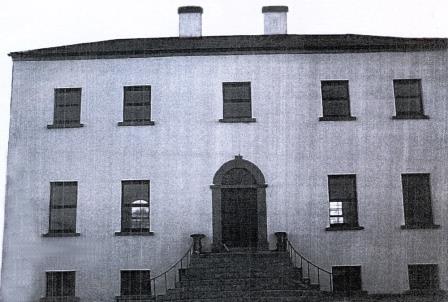
|
| Moylurg House | In 1837 Lewis records Moylurg house as the seat of the Dick family. Rev. William Robertson was leasing a property valued at £25 to John Johnston, at Clogher, parish of Eastersnow, at the time of Griffith's Valuation. This appears to be Moylurg House which is still extant. Moylurg was the home of Major Henry Taaffe Ferrall in the 1870s. |

|
| Cavelawn | Guy Lloyd was leasing a house at Faus valued at £10 to James Acheson at the time of Griffith's Valuation. The house at this site is labelled Cavelawn on the 25-inch Ordnance Survey map of the 1890s. A house is still extant at the site. | |
| Havarine Cottage | Anna Maria Fry was leasing a house valued at £11 from Lord Lorton's estate at Tullyvohaun, barony of Boyle, at the time of Griffith's Valuation. At the time of the first Ordnance Survey Havarine Cottage, at Tullyvohaun, was described as a ''gentleman's seat', the residence of Mrs. Fry. | |
| Frybrook House | Frybrook House was built by Henry Fry, who came to Boyle in 1742, and established a weaving industry in the town. It is still extant. In 2025 it was offered for sale. |

|
| King House | King House was built between 1720-1740 by Sir Henry King. In 1786 Wilson wrote "the Earl of Kingston has a very fine house at Boyle, situated near the ruoins of an ancient abbey". Following a fire in 1788 the King family vacated the house and moved to Rockingham on the shores of Lough Key. King House was used as a military barracks until the 1960s. It is now in the ownership of Roscommon County Council and is open to the public. |

|
| Lough Key House | At the time of Griffith's Valuation, Alicia Peyton was leasing a house valued at £13 at Ballykeevican, barony of Boyle, from Viscount Lorton's estate. This property is now Lough Key House guesthouse. |

|
| Carrickard House | At the time of Griffith's Valuation, Charles Peyton was leasing a house at Keeloges, valued at £25, from Lord Lorton's estate. |

|
| Riversdale House | John R. French was leasing a house valued at £25 at Kilateasheen from the Ecclesiastical Commissioners at the time of Griffith's Valuation. There is no substantial house marked on the 1st edition OS map. This house is still extant and known as Riversdale House. |
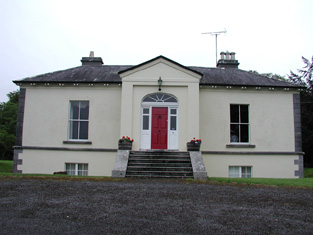
|
| Croghan | At the time of Griffith's Valuation, Guy Lloyd was the occupier of the house at Croghan, valued at £40. In 1749 the Census of Elphin shows that J. Lloyd, spinster, lived there. Wilson also notes it as a seat of the Lloyd family in 1786. Croghan House is no longer extant but an extensive range of outbuildings remains. |

|
| Cloverhill | At the time of Griffith's Valuation, Thomas Cox was leasing a house from the Lloyd estate at Bunreagh, barony of Boyle, valued at £10 . This property is labelled Cloverhill on the 25-inch map of the 1890s. A house and substantial farn are still extant at the site. | |
| Hermitage | Lewis records the Lloyd family occupying a second house called Hermitage also located in the townland of Croghan. Buildings still exist at the site. | |
| Cloongownagh | Thomas and Andrew Kirkwood had houses in this locality in 1814. Thomas resided at Hermitage and Andrew at Lakeview. At the time of Griffith's Valuation Andrew Kirkwood was occupying a property at Cloongownagh, barony of Boyle, valued at £13. Keenehan and others state that Cloongownagh House was built in 1690. It was occupied by the Kirkwood family until 1939 when Col. Moore Kirkwood sold the house and 109 acres. The house is still extant and occupied and is now part of a farm. | |
| Woodbrook House | Keenehan and others state that Woodbrook House was built around 1780 by the Phibbs family although there may have been an earlier house on the site. The Kirkwood family purchased the property sometime in the early nineteenth century. At the time of Griffith's Valuation Sarah Mary Kirkwood was leasing a house at Usna, barony of Boyle, valued at £14, from Robert H. Brewster French. From the 1890s-1911 Woodbrook was a very successful racing stables run by Colonel Tom Kirkwood. Life in the house in the post-WWI era has been made famous by the memoir ''Woodbrook'' written by the Scottish author David Thomson, a tutor to the daughters of the family. In 1946 over 50 acres of the estate was sold to the local golf club while the Land Commission subsequently divided the remainder. Woodbrook House is still extant. | |
| Springfield House | At the time of Griffith's Valuation, John Keogh was leasing a house at Cultycuneen, barony of Boyle, valued at £13, to Joseph Backhouse. Keenahan and others state that this house was built by the Backhouse family in the 1790s. It remained in the family until the mid twentieth century. It is still extant and has been recently refurbished. | |
| Carrowreagh | Richard O'Farrell Caddell was leasing a "herd's" house valued at £8, together with over 350 acres, at Carrowreagh, barony of Boyle, to Thomas Boylan, at the time of Griffith's Valuation. A house and farm are still extant at the site. Patrick Fox was leasing a mill property from the Caddell estate in the same townland. Some stone buildings remain at the site though the mill was described as "in ruins" on the 25-inch Ordnance Survey map of the 1890s. | |
| Finnor House | At the time of Griffith's Valuation, Richard O'Farrell Caddell was leasing a house valued at £8, at Finnor, barony of Boyle, to Michael Barrett. It s labelled "Finnor House" on the 25-inch Ordnance Survey map of the 1890s and a house still exists at the site. | |
| Bella | At the time of Griffith's Valuation Arthur O'Connor was the lessor of a caretaker's house, valued at £2 10s, as well as 136 acres. Lewis recorded Bella as the residence of E. French in 1837. A ruin is still extant at the site. An entrance gateway named Flynn's Cottage is visible here now! | |
| Dooneen | The representatives of Daniel Ferrall were leasing a property valued at £5 together with 200 acres to John Sharkey at the time of Griffith's Valuation. A farm is still extant at this location. | |
| Scor More | At the time of Griffith's Valuation, Scor More was leased to Patrick Beirne by the Lloyd estate and was valued at £3. 100 acres was also leased. This house is not shown on the 1st edition of the OS map. | |
| Kingsland | At the time of Griffith's Valuation John Conmee was leasing a property valued at £12 from Viscount Lorton's estate at Kingsland, barony of Frenchpark. He had been in possession of this property since at least 1814. Matthew Conmee also leased a property in the same townland, valued at £6 together with 190 acres, from Lord Lorton's estate. |
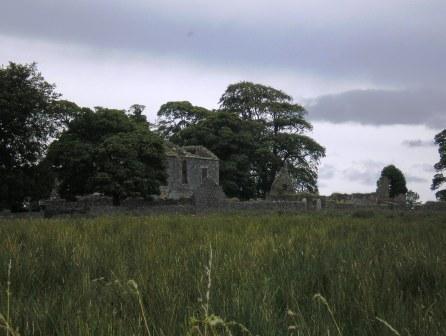
|
| Barnaboy | Francis O'Grady was leasing a property at Barnaboy, barony of Frenchpark, valued at £4 15s together with 179 acres of land from William Longfield's estate at the time of Griffith's Valuation. Farm buildings exist at the site now. | |
| Portobello | At the time of Griffith's Valuation, John Stafford was leasing a property at Portobello valued at £13 from Lord Lorton's estate. In 1814 it had been the residence of Thomas Stafford who Lewis also recorded as resident there in 1837. | |
| Ryefield | At the time of Griffith's Valuation Andrew Cummins was leasing a house at Ryefield valued at £17 to John Dowd. It was occupied by John Cummins, agent to Nicholas Cummins at the time of the first Ordnance Survey. | |
| Ratra House & Stables | Lord de Freyne held a house valued at £4 10s at Ratra, barony of Frenchpark, at the time of Griffith's Valuation. In 1814 Ratra was the residence of Henry Irwin. A house, labelled Ratra, is shown on the 1st edition Ordnance Survey map. A larger building, on a different site, is labelled Ratra House on the later 25-inch edition [M684939]. Neither of these house are extant now. Offices, the property of Lord de Freyne's estate and valued at £7 10s, were located at Clashcarragh, barony of Frenchpark, at the time of Griffith's Valuation. |

|
| Sheepwalk | James McGann was leasing a property at Sheepwalk, barony of Frenchpark, valued at £10, from Lord de Freyne's estate at the time of Griffith's Valuation. The townland of Sheepwalk contains a fine collection of early to mid-twentieth century houses and associated farm buildings. One house, now derelict, appears to be earlier and has large associated outbuildings. |

|
| Cloonshanville | William Davis was the occupier of a property valued at £8, together with over 120 acres at Leggatinty, barony of Frenchpark, at the time of Griffith's Valuation. In the same townland he was leasing a property, including a corn mill, valued at £18, to James McCann. In 1814 Paul Davis was resident at Clonchanville, Frenchpark and Lewis records this as the seat of J. Davis, in 1837. The 1749 Census of Elphin records W. Davis resident at Clegarna in the parish of Tibohine. Only some foundation stones of Cloonshanville Mill remain. There is a house, probably not original, on the site of Cloonshanville House. |

|
| Hermitage | Built by Charles O'Conor (1710-1790) the antiquarian and head of the family circa 1760. His great great grandson Charles O'Conor was leasing the property at Ballaghcullia, valued at £10, to Honoria O'Conor at the time of Griffith's Valuation. In 1749 the Census of Elphin records Denis O'Conor as being of "Ballinagar". The house at Hermitage is still extant though not occupied and a modern bungalow has been constructed in front of it. |

|
| Kilcorkey | Denis O'Conor held a property including a mill, valued at £10, at Kilcorkey, barony of Castlereagh, at the time of Griffith's Valuation. In 1749 the Census of Elphin recorded Richard Rutledge, gentleman, as the holder of a property in Kilcorkey. A house and extensive outbuildings still exist at the site but both have been modernised. The outbuildings have been coverted to living accommodation. An impressive standing stone is visible in the field close to the rear of the house. |

|
| Mount Druid | Denis O'Conor's house at Mount Druid, barony of Castlereagh, was valued at £35 at the time of Griffith's Valuation. In 1814 and 1837 the house was the seat of Matthew O'Conor. Slater refers to it as the seat of Charles M. O'Conor in 1894. A modest house survives at the site of Mount Druid but the stable yard remains are more elaborate. Fine trees still exist in the former demesne land. |

|
| Peak | Richard Irwin owned a herd's house and over 370 acres at Peak, barony of Castlereagh at the time of Griffith's Valuation. A modern house has been constructed at the site. | |
| Hughestown | The seat of the Mulloy family is described as Hughestown but at the time of Griffith's Valuation the buildings at this location are described as "offices" and have a low valuation. C.M. Mulloy was resident at "Husetown"in 1749. Wilson refers to Hughes-town as the seat of Mr. Molloy in 1786. In 1814 Hughestown was the seat of Mulloy McDermott. | |
| Ellesmere | Harloe Powell was leasing a house valued at £18 at Ardcarn, barony of Boyle, from Viscount Lorton's estate, at the time of Griffith's Valuation. This house is still extant and occupied. |

|
| Lyonstown | At the time of the first Ordnance Survey a large ruin, said to have been the residence of the Lyons family, was in the possession of the O'Donnell of Greyfield estate. | |
| Abbey View House | Morgan Crofton, agent to Lord Lorton, was residing here at the time of the first Ordnance Survey. At the time of Griffith's Valuation it was occupied by Caleb Robertson and valued at £34. A house is still extant at Abbey View. |

|
| Coote Hall | In the seventeenth and eighteenth centuries Coote Hall was owned by the Coote family. The 4th and 5th Baronets, both named Charles, lived there and it was one of the houses O'Carolan visited and for whom he composed tunes. It was bought by Maurice O'Conor in the 18th century and later again by the Barton family. There is still an extant house at the site. |
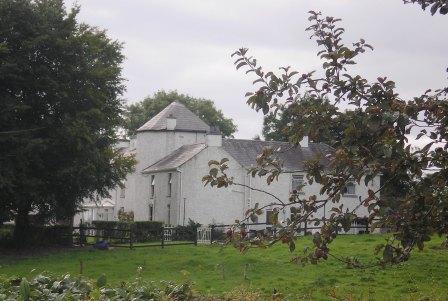
|
| Mullen | In 1837 Lewis records a house named Mullen as the seat of Lynch Plunkett. The 1749 Census of Elphin records Mullen or Mullin, in the parish of Tibohine, barony of Frenchpark, as the residence of J. Barlow. The house, labelled Mullen, is shown on the 1st edition Ordnance Survey map but does not appear on the later 25-inch edition of the 1890s. | |
| Rathkeery Glebe | Rev. William French was leasing a glebe house at Glebe East, barony of Frenchpark, from Lord de Freyne's estate at the time of Griffith's Valuation when it was valued at £7. The house no longer survives but an entrance gateway and trees indicate its whereabouts. |

|
| Cavetown | In 1786 Wilson notes Cavetown as the seat of the Rev. Dean Mahon and the Reverend Arthur Mahon resided there in 1814. At the time of the first Ordnance Survey a ''gentleman's seat of two stories'' is noted in Cavetown. Guy Lloyd is recorded as the proprietor. This may be the property, valued at £5, leased from the Lloyd estate by Geo. Laird at the time of Griffith's Valuation. There are buildings still extant at this site. |

|
| Granny | At the time of the first Ordnance Survey Granny was described as ''a good farmhouse, the residence of the proprietor'' who was Thomas Irwin. Both Leet and Lewis record the Irwin family having a seat at Granny, near Boyle, in 1814 and 1837 respectively. A modern building is extant at the site now. | |
| Rushfield | At the time of the first Ordnance Survey Mr. A. Irwin is noted as the occupier of one of two ''gentlemen's seats' at Tullyvohaun, barony of Boyle. In 1814 it was the residence of John Irwin. This property was valued at £8 and was occupied by William Phibbs at the time of Griffith's Valuation. A substantial farm still exists at the site. | |
| Mantua | Built in the mid 18th century and owned by the Grace family in the 18th and 19th centuries. Occupied by R. Underwood in 1778. In 1786 Wilson notes that it was the seat of the late Richard Underwood and of Captain Grace. The 1st edition Ordnance Survey map indicates that it had elaborate gardens with a fishpond and terrace. It was owned by Edward F. Bowen in 1906. Mantua is now a ruin. | |
| Clogher Beg | Mary Gormley writes that this house was built by the Knoxes who acquired some of the Plunkett of Castle Plunkett estate. Occupied by Thomas Stafford at the time of Griffith's Valuation, held from James Murphy. | |
| Raheen | Occupied by Major Fawcett in 1837 and by John Irwin in the mid 1850s who held the property from Francis Murphy. In 1840 John Irwin had married Margaret Harken of Raheen House, Elphin. |

|
| Atteville | Both Leet and Lewis indicate that Atteville was the seat of the Knott family with William residing there in 1814. At the time of Griffith's Valuation the property was in the possession of William Phibbs. It is described as a "herd's house" and was valued at almost £2. | |
| Kilfree | At the time of Griffith's Valuation Charles Costello was leasing a property valued at almost £7 together with 140 acres at Kilfree, barony of Coolavin, from the O'Farrell Caddell estate. Lewis records Kilfree as the seat of Edward Costello in 1837. Earlier, in 1802, McParlan mentioned "Mr. Costello of Gortin" as one of the principal residents of the area. McTernan states that the house and estate were eventually sold under the Land Acts. The ruins of the house are still visible. | |
| Ardgallin | At the time of Griffith's Valuation Harloe Baker was leasing a house valued at £7, together with over 80 acres, at Ardgallin, barony of Coolavin, from Viscount Lorton's estate. Lewis also records Ardgallin as the seat of Harloe Baker in 1837. McTernan notes that the Baker family sold their interest to Thomas Bell, of Larkhill House, Quarryfield, in 1887. It came into the ownership of the Cornwall family in the 1920s who are still in possession. | |
| Carrickard | At the time of Griffith's Valuation, Rev. Arthur Hyde was leasing a house at Carrickard, barony of Tirerrill from the estate of Robert Gough. The house was valued at £8. | |
| Brick Field | At the time of Griffith's Valuation William Phibbs held a property valued at £6 at Knockbrack, barony of Corran. In 1906 this property was valued at £11. | |
| Bellanagare Castle | Bellanagare was the home of the O'Conor family including the well-known historian Charles O'Conor. It is noted by Wilson as his seat in 1786. He later built Hermitage House some distance away and Bellanagare Castle is now in ruins. |
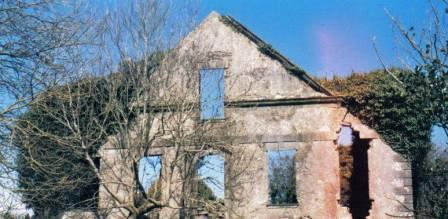
|
| Drum Lodge | One of the many surviving gatelodges on the Rockingham Demesne. |

|
| Andresna | Meredith Thompson was leasing a property valued at £6 at Andresna, barony of Tirerrill, to William Thompson at the time of Griffith's Valuation. | |
| Castlefield House | At the time of Griffith's Valuation Meredith Thompson, senior, was occupying a house valued at over £5 at Anresna, barony of Tirerrill. This appears to be the house marked on the OS map as Castlefield House, on the shores of Lough Arrow. McTernan notes that it later came into the possession of the Acheson family who sold it in 1935. It is still extant but in 2009 was unoccupied. | |
| Templevanny | McTernan notes that Templevanny House was commenced in 1846 but not completed until after the Famine. At the time of Griffith's Valuation, it was held by Margaret and Henry Gorman from Viscount Lorton's estate with a valuation of £2. It continued in the Gorman family until the 1920s. The building is still extant though derelict. | |
| Cloontykilla Castle | This building was constructed after the publication of the first Ordnance Survey Map. It appears to have functioned as a shooting/fishing lodge for the King estate. It is now a ruin. |
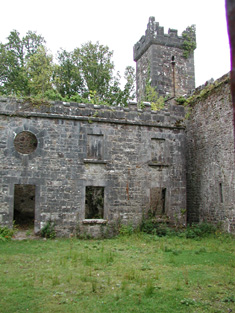
|
| Lung House | In 1786 Wilson refers to "Long" as the seat of Mr. Dillon. This appears to be Lung House, labelled as "in ruins" on the 1st edition Ordnance Survey map. | |
| Crohy House | Crohy House was occupied by Francis Foster, leasing from the Conyngham estate at the time of Griffith’s Valuation. |

